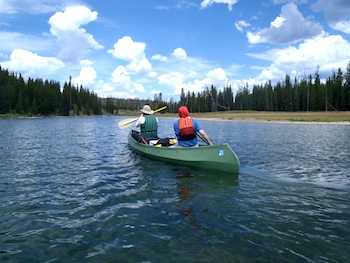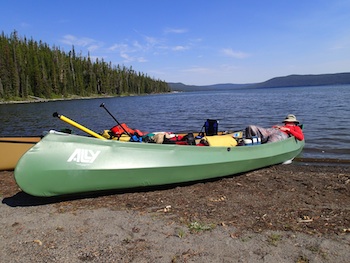Nimble and responsive, the Ally was firm, if not entirely rigid, as we paddled into the swells on Shoshone Lake in Yellowstone National Park. This Norwegian curiosity was no slouch on the lake, and even handier on the Lewis River Channel.
That the Ally isn't often seen on U.S. waterways isn't terribly surprising. It debuted in Norway in 1972 and focuses on a relatively small niche market -- those looking for a packable canoe, either for storage reasons or to transport with your luggage when flying to your next paddling destination. And reviewers haven't always embraced the struggles of putting the canoe together.
An offshoot of Bergans of Norway, a company better known for its outdoor clothing and packs, the Ally is trying to gain traction here in the United States. It has more than a few things going for it:
* As noted above, it's a good, responsive canoe. We took a 44-pound, 16.5-foot DR for five days on Shoshone Lake in mid-August and were generally quite pleased with its performance, both on the Lewis River Channel that ties Lewis and Shoshone lakes together, and in the open waters of both lakes.
"It's nimble on the river," pointed out my youngest son, Sean. "Considering what we went over, it held up really well."
Added my long-time backcountry traveling partner Bob Mishak, "It reacted very easily, it was responsive, almost too responsive. It was very easy to turn. It's not a lake canoe. I enjoyed it very much going down river."
* It's unique design -- a reinforced PVC skin stretched (and I mean stretched) over a skeleton of aluminum framing -- makes the canoe rigid and yet flexible, something we definitely noticed going through the swells of Shoshone Lake; the person in the bow would be going down a swell while the one in the stern would be climbing up it.

Heading up the Lewis River Channel. Kurt Repanshek photo.
The PVC skin, though it might appear questionable in encounters with rocky river bottoms or beaches, held up superbly through the bony section of the Lewis River Channel. While my Wenonah Odyssey gained some new scratches to its gel-coat bottom, the Ally didn't display any scratches.
* It's highly portable. The Ally breaks down into the PVC skin, a foam floor, and aluminum tubing that is shock-corded together. It all fits into a large duffle bag, also made from PVC, that allows you to stow it in your attic, garage, or spare room, add it to your airline luggage, or portage it if you're facing a particularly long portage.
But...it has one main drawback. Assembly is required, and it can be a bear.
Though the company proclaims that the Ally "is easy to assemble," that, sadly, is not exactly the case. Though the canoe comes with a video showing one man calmly and easily putting together the Ally, and you can find other videos on the Internet showing much the same thing, they don't reveal all the struggles one might encounter the first time or two you assemble the canoe.
That should be obvious when you see the canoe comes with a rubber mallet.
My first attempt at assembly (with three others) led to more than a little frustration, and a little spilled blood, over more than two hours during which we failed to get the job done. The second attempt went somewhat better -- possibly due to the fabric having been stretched a few times by now --, and the third attempt the night before we put in on Lewis Lake was the easiest, as Bob and I had figured out most of the tricks and were able to build the boat in less than an hour.
Deconstruction is quick and easy: A few well-placed whacks with the mallet is all that's needed to take down the thwarts.
Placement of the seats is key to how easy the 16.5 DR, which has a slight rocker to it, is to paddle. While the bow seat really only has only place it can go, the stern seat can be moved about 2 feet fore or aft. Too far forward and you'll struggle to control the canoe. We found placing the seat as far back as possible made it much more maneuverable, as you had better leverage.
And while the foam floor provides some insulation from cold lake waters, an additional kneeling pad can come in handy, both to provide extra cushioning and to protect your knees from the chine rods running the length of the floor.

The Ally is just as comfortable beached as it is on the water. Bob Mishak photo.
One afternoon, after we had unloaded the gear from the Ally, I took the canoe out on Shoshone Lake by myself to pump some water. It proved to be easily maneuvered, either from a kneeling position near the center thwart or from the rear seat. And it was fun, turning almost on the proverbial dime.
After the trip, we came away with two suggestions: One, Bergans should include a small wedge for use with the mallet when it comes to knocking the C-clips that help hold the chines in place into, and out of, place. Two, provide a comfortable alternative to the hard plastic tractor seats.
A bonus would be to toss in a six-pack of either Lundetangen or Ringnes to toast your success in assembling the Ally!
Bottomline: The Ally comes in eight different versions, from a 13.7-footer for flat water travels to an 18.5-footer for cruising big lakes. In hindsight, we definitely should have gone with a longer boat for this trip. Pricing ranges from roughly $1,900 to roughly $2,500. If you have storage issues, or like to travel great distances with your boat, this would be a good option to consider.


 Support Essential Coverage of Essential Places
Support Essential Coverage of Essential Places






